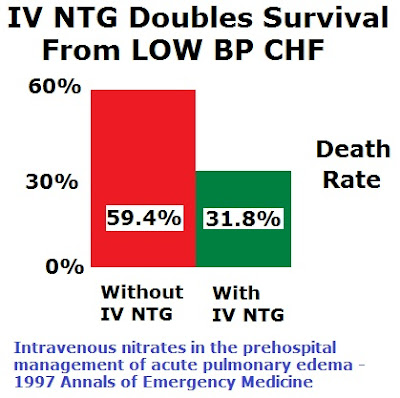EMT-Medical Student had this response to Comment from usalsfyre on Is IV Bolus Nitro Dangerous – Part I about giving boluses of IV (IntrVenous) NTG (NiTroGlycerin).
–
Maybe I’m missing something here, but shouldn’t infusions begin with a loading dose (bolus) anyways? After all, isn’t the primary purpose of an infusion to maintain a steady therapeutic concentration in the patient’s system instead of reaching a therapeutic concentration?
–
bolus
1. Any concentrate given as a single dose to achieve an immediate effect
2. Any mass or blob–eg, masticated food, in transit through a tube
Endocrinology An extra boost of insulin given to cover expected rise in blood glucose–sugar such as the rise that occurs after eating
Therapeutics A large IV dose of a drug given “all at once” at the beginning of treatment, which raises the concentration in the body to a therapeutic levelMcGraw-Hill Concise Dictionary of Modern Medicine. © 2002 by The McGraw-Hill Companies, Inc.[1]
With most medications, we start off with a dose that has a reasonable expectation of quickly bringing the patient close to a therapeutic level of medication, but with IV NTG we are supposed to start at such a ridiculously low infusion rate, that it is almost homeopathic.
–
It is generally agreed in the literature that for intravenous administration, the initial dosage should be set to 5 μg/min and this dose increased by 5 μg/min every 5 minutes until the desired effect is achieved or systolic blood pressure decreases below 100 mm Hg or a dose of 200 μg/min is attained.2[2]
Starting a 5 μg/minute and increasing by 5 every 5 minutes, it will take 195 minutes to get to 200 μg/minute.
That is 3 hours 15 minutes of increasing the infusion at the fastest rate these doctors felt would be possible.
How many of these patients died because of that kind of You can’t be too careful treatment?
–
It isn’t so much a problem with understanding what a bolus is for as it is a problem with the medication that is being given as a bolus. Giving a NTG bolus IV is also unsettling, but this series of posts started with a discussion of the ACLS (Advanced Cardiac Life Support) prohibition on giving more than 3 doses of SL (SubLingual) NTG to a patient.
We are supposed to be content with getting to a therapeutic level of NTG so gradually that no bureaucrat will be made uncomfortable by the idea.
How many patients die because we are too afraid to treat them with appropriate bolus doses of NTG?
–
We are supposed to be terrified of giving IV bolus NTG to hypotensive CHF patients, but their death rate was cut in half by IV bolus NTG.[3]
–
Are IV boluses of nitro dangerous?
Why isn’t there any evidence of danger?
Why is there so much fear of IV nitro boluses?
If we should be using boluses to reach therapeutic levels, why is nitro different?
Why isn’t there any evidence of harm from IV nitro boluses?
Why do we continue to behave so unethically?
–
–
Why do we continue to choose to sacrifice witches, rather than learn from our mistakes?
–
Footnotes:
–
[1] bolus
The Free Dictionary
Medical Dictionary
Definition
–
[2] Preclinical intravenous nitroglycerin therapy.
Roeggla G, Hauser I, Wagner A, Roeggla M.
Ann Emerg Med. 1998 Mar;31(3):416. No abstract available.
PMID: 9506507 [PubMed – indexed for MEDLINE]
–
[3] Intravenous nitrates in the prehospital management of acute pulmonary edema.
Bertini G, Giglioli C, Biggeri A, Margheri M, Simonetti I, Sica ML, Russo L, Gensini G.
Ann Emerg Med. 1997 Oct;30(4):493-9.
PMID: 9326864 [PubMed – indexed for MEDLINE]
.




Just thinking it through, in a situation where a patient was given multiple multi-spray SL doses of NTG and then an infusion was started, could you not say that the SL NTG was the “bolus” dose and you are now starting the drip as a maintenance infusion? Or is SL too unpredictable to do that?